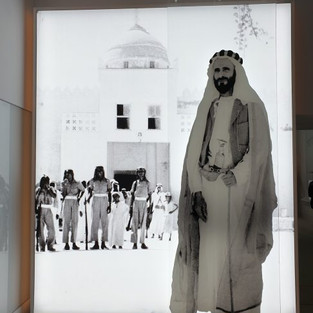Why Qasr Al Hosn Should Be On Your Abu Dhabi Itinerary
- Marina Milic

- Feb 27, 2019
- 3 min read
Updated: Jul 29, 2022
Qasr Al Hosn is Abu Dhabi’s oldest building, constructed in the 1790’s to serve as a watchtower and command post. Although it is located in the heart of the city centre today, back then, it protected the growing settlement and overlooked coastal trade activities. The national monument underwent an 11 year long restoration and was unveiled to society as a museum in December 2018, displaying the history of Abu Dhabi from a pearling settlement, to the cosmopolitan metropolis it is today.
So why visit?
SANCTUARY IN THE MIDDLE OF THE CITY
To start, it is quite literally an oasis in the midst of the busiest part of the city. The complex is built with surrounding walls which create an isolation from the noisy traffic, while the effect inside retains tranquility further enhanced by a bay of water. Apart from visiting the historical landmarks, visitors can easily enjoy walking around the massive complex.
HISTORY
The fort has stood the test of time from being a simple watchtower to the home of the Al Nahyan ruling family. It is comprised of two structures, the Inner Fort which showcases everyday life in the 18th century, while the Outer Palace shares insight into what life was like in the 1940’s & 1950’s. Visitors can climb up to the watchtower and enjoy vistas of the complex, stroll through the palace corridors while imagining what everyday life must have been like. Artifacts and personal archives ranging from documents and books, to weapons and old recordings are on display, dating back to 6,000 BC.
HOUSE OF ARTISANS
A beautiful addition to the complex features the House of Artisans which displays the handiwork and traditional craft making, celebrating the past while preserving intangible heritage for the future. Visitors will learn all about Al Sadu – a traditional form of weaving using wool, Khoos – a weaving technique using date palms, Talli – a decorative form of embroidery, and witness sea-craft which form an integral part of Emirati culture and are still used in many households today.
GALLERIES
Utilising the latest digital automation, the main gallery brilliantly blends technology with art to create an immersive storytelling experience through 6 chapters. At the start of the visit you can learn all about how the Bani Yas tribe migrated through the desert until they found a home in Abu Dhabi. The next galleries exhibit how the Bedouin survived and thrived in the harsh desert climate showcasing the food they ate, the materials they used to build houses or make clothing, and goes deep into showcasing the traditions they built. The last few galleries showcase how the chain of command started and was passed on until today highlighting every ruler’s achievements – most notably Sheikh Zayed’s.
WORKSHOPS
In a city filled with a diverse range of food and recreational activities to do no matter what your hobby is, I love that Qasr Al Hosn offers workshops for visitors to learn about the traditional arts and crafts such as weaving date palms using the Khoos method, henna styling, and more. The complex also puts on daily and weekly cultural events such as the changing of the guards, a traditional Al Ayyala performance, Al Taghrouda poetry, falcon demonstrations, and much more.



The museum is open daily from 9am – 7pm Saturday until Thursday, and from 12pm until 10pm on Fridays with an entrance fee of AED 30 for adults. The complex also features a contemporary art museum which is filled with paintings, sculptures, and impressive sketches from local artists.
xo,
Marina
Visit Information:
Official website: http://www.qasralhosn.ae
Address: click here
Tickets: ww.qasralhosn.ae/book-now
Free underground parking is available
Disclaimer: All views are my own and all photographs are © My Sweet Escapes, unless otherwise stated. Basket weaver image courtesy Qasr Al Hosn.











































Comentarios